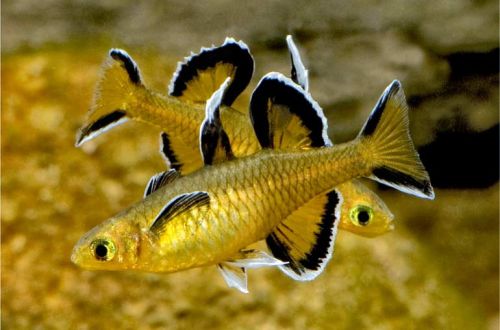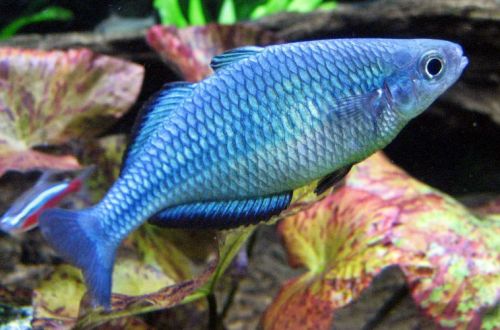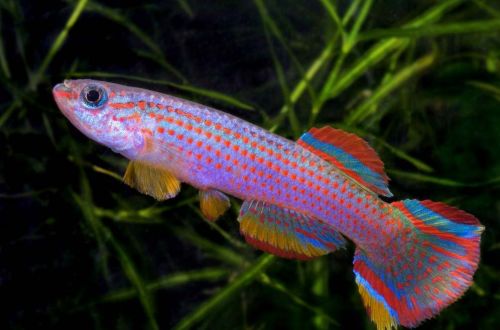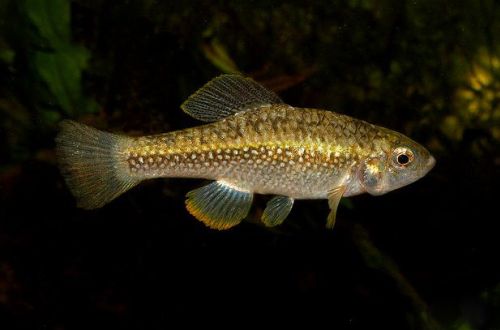
Pseudomugil Mellis
Pseudomugil mellis or Honey blue-eye, scientific name Pseudomugil cyanodorsalis, belongs to the family Pseudomugilidae (Pseudomugilliaceae). An unpretentious, easy-to-keep agile fish, distinguished by its bright coloration and peaceful disposition.

Contents
Habitat
Endemic to Australia, found in coastal river systems in the northeast of the continent, mainly in the state of Queensland. Inhabits swamps, small streams with sandy or silty substrates and dense aquatic vegetation. The water in this area has a rich brown hue due to the high concentration of tannins (tannins). They can also inhabit clear flowing water bodies.
Description
Adult individuals reach a length of 3-4 cm. These fish are characterized by sexual dimorphism. Males look brighter and more colorful, the main color is yellow-orange (honey). The fins and tail have a contrasting black and white border. Females, in turn, are not distinguished by the brightness of colors, in which gray shades predominate.
Behavior and Compatibility
Peaceful moving fish. There is competition between males for the attention of females, especially during the breeding season. During the spawning period, males begin to show territorial behavior, protecting the clutch. As a rule, rivalry is demonstrative in nature, and males do not injure each other. Nevertheless, it is recommended to purchase a group with a numerical predominance of females in an aquarium.
In nature, the Blue-eyed Honeymoon shares its habitat with other Rainbowfishes, which can make good neighbors provided species of comparable size are selected.
Brief information:
- The volume of the aquarium – from 60 liters.
- Temperature – 24-28°C
- Value pH — 5.5–8.0
- Water hardness – soft to hard (5-21 dGH)
- Substrate type – any
- Lighting – subdued / moderate
- Brackish water – no
- Water Movement – Low/Moderate
- The size of the fish is up to 3-4 cm.
- Food – any food
- Temperament – peaceful active
- Keeping in a flock of at least 8-10 individuals
- Life expectancy about 2 years
Maintenance and care, arrangement of the aquarium
They are easy to maintain, able to successfully adapt to changes in the hydrochemical composition of water and temperature, including during the day. For example, in the natural habitat, temperature fluctuations from 20°C to 30°C and above occur regularly, and during the cold season it is not uncommon for temperatures to drop to 10°C. Thus, Pseudomugil Mellis can live in an unheated aquarium.
Despite its unpretentiousness, soft acidic water in the range of pH 5.5–6.5 and dGH up to 10 is considered the most comfortable environment.
The optimal size of the aquarium for a group of 8-10 fish starts from 60 liters. The design welcomes the presence of thickets of plants. Otherwise, the design is not significant and is selected at the discretion of the aquarist.
In long-term maintenance, the focus is on water quality. Of great importance is the weekly replacement of part of the water with fresh water (at least 20% of the volume) and the regular removal of accumulated organic waste.
Food
Omnivorous species. They will accept most popular foods of the right size. It can be dry flakes, granules, live or frozen brine shrimp, bloodworms, daphnia, etc.
Breeding / Breeding
Spawning is seasonal and usually occurs between November and January. If breeding is planned, then for this period it is worth placing the fish in a separate pre-prepared tank.
In a spawning aquarium, dense, low-growing plants such as Java moss should be provided. In them, females will lay eggs, which will be held on the surface of plants with sticky threads.
The fry that have appeared also need protection, but this time in the upper layer of water. Floating plants such as Riccia and Mexican Hornwort will provide a safe haven from the attention of adult fish that tend to eat their own offspring.
Fish spawn from 7 to 9 days. Every day, the female on average lays up to 15 eggs.
In order to preserve the offspring of adult fish at the end of spawning, it is recommended to move back to the general aquarium.
Taking into account the fact that the Honey blue-eye lives only about two years, one-year-old individuals demonstrate the highest fertility.
The incubation period depends on the temperature. At 24°C fry will appear in 12–14 days, and at 25–27°C already after 5–8 days. The first days of life, the fry hide in the thickets of plants near the surface. Then they begin to swim throughout the entire volume of water, feeding mainly in the middle or bottom layer.





